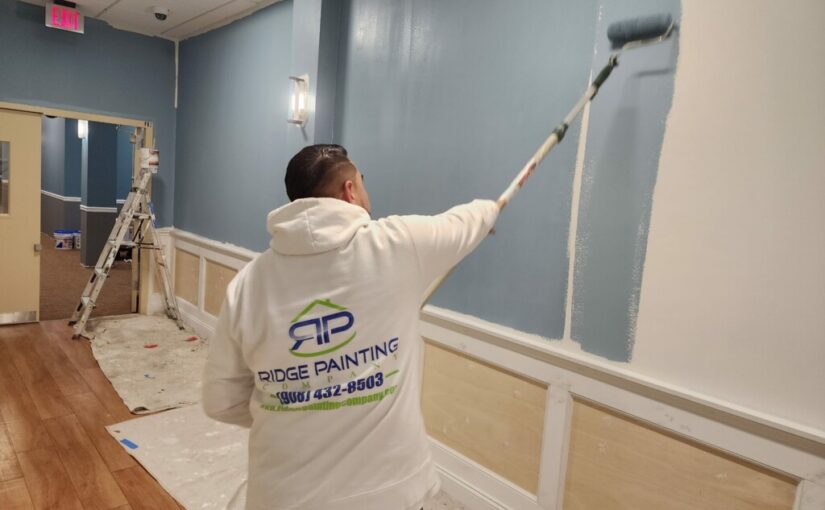Navigating Paint Fumes and Choosing Low-VOC Options: A Guide to Healthier Interior Painting
When it comes to painting interiors, two of the most common concerns are the impact of paint fumes and the availability of low-VOC or eco-friendly paints. Many people worry about how noticeable fumes will be, how long they’ll linger, and when it’s safe to return to a freshly painted space. With health and sustainability on everyone’s mind, there’s also a growing interest in low-VOC paints and whether they can match the durability and coverage of traditional options. In this article, we’ll dive into these questions to help you make informed choices for a healthier and more enjoyable painting experience.
Will the Paint Fumes Be Noticeable?
One of the first things people notice during an interior painting project is the smell. Traditional paints, especially oil-based ones, can produce a strong odor due to chemicals called volatile organic compounds (VOCs). VOCs are used in paint to improve application, drying time, and durability, but they release fumes as the paint dries. These fumes, often noticeable as a sharp or chemical smell, can linger for hours or even days in enclosed spaces. They can also cause short-term symptoms like headaches, dizziness, and eye or respiratory irritation, especially for people sensitive to chemical odors.
The level of noticeable fumes depends on several factors, including the type of paint, ventilation in the room, and the amount of paint applied. For example, oil-based paints typically emit stronger fumes than water-based paints, and painting in smaller, poorly ventilated areas tends to intensify the odor. Fumes can be more noticeable in colder weather when windows are closed, making it harder for fresh air to circulate. In contrast, painting in warmer weather or in well-ventilated spaces can help reduce the smell.
How Long Should I Wait Before the Room is Safe to Occupy?
The general recommendation is to wait at least 24 hours before spending significant time in a freshly painted room. For people with respiratory sensitivities, allergies, or conditions like asthma, a longer wait—up to 48 hours—is often advised to allow fumes to dissipate more fully. Additionally, some factors, such as the number of coats applied or the size of the space, can influence how long it takes for fumes to clear. A larger room with good ventilation will generally clear faster than a smaller, enclosed area.
Ventilation is key to minimizing exposure to paint fumes. Open windows and doors if possible, and use fans to create cross-ventilation that draws fresh air in and pushes fumes out. Exhaust fans, such as those found in bathrooms or kitchens, can also help direct fumes outside. If you’re painting during colder months, a small portable fan can be placed near an open window to help circulate air without letting too much cold air into the space.
When planning a painting project, try to avoid using rooms immediately after painting, especially for activities involving children or pets, who may be more vulnerable to chemical exposure. Children, for instance, may be more sensitive to VOCs, and pets could be bothered by the lingering odor. Ideally, rooms such as bedrooms or nurseries should be painted when you can keep them unoccupied for several days or when you can use adjacent rooms for temporary sleeping arrangements.
Low-VOC and Eco-Friendly Paints: An Overview
In response to health concerns about traditional paints, low-VOC and eco-friendly paints have become widely available, offering a healthier alternative. Low-VOC paints contain fewer volatile organic compounds than standard paints, significantly reducing the strong odor and fumes that can linger for days. In fact, some low-VOC paints produce little to no noticeable smell, allowing you to use the room sooner and with fewer concerns about air quality.
Eco-friendly paints go a step further by incorporating natural ingredients and removing synthetic chemicals, making them an ideal choice for people looking to minimize their environmental impact. Zero-VOC paints are also available, and while they may still contain trace amounts of VOCs, these levels are generally so low that they produce virtually no fumes. Many popular paint brands now offer both low-VOC and zero-VOC options in a wide range of colors and finishes, making it easier than ever to choose a healthier product that fits your design needs.

Do Low-VOC and Eco-Friendly Paints Provide the Same Durability and Coverage?
A common concern with low-VOC and eco-friendly paints is whether they can match the performance of traditional paints, especially in terms of durability and coverage. The good news is that advancements in paint technology mean that low-VOC options now rival or even outperform many standard paints. Today’s low-VOC and zero-VOC paints are available in various finishes, such as matte, satin, and semi-gloss, and they provide excellent coverage, vibrant color, and long-lasting protection for interior surfaces.
Historically, low-VOC and eco-friendly paints were known to have slightly thinner coverage or require more coats, but these issues have largely been resolved. Most major paint manufacturers have invested in research to ensure that their low-VOC options deliver strong adhesion, durability, and resistance to wear. However, as with any paint, the preparation process—including cleaning, priming, and applying the correct number of coats—remains essential to achieving a professional and lasting finish.
For high-traffic areas like hallways or kitchens, consider choosing low-VOC paint with a more durable finish, like satin or semi-gloss, to ensure it withstands daily use and frequent cleaning. These finishes tend to resist stains and scuffs better than matte options, which is a consideration when choosing paint for spaces prone to fingerprints, splashes, and bumps. Eco-friendly and low-VOC paints are now widely accepted as being as durable as traditional paints, making them suitable for both residential and commercial settings.
Additional Benefits of Low-VOC and Eco-Friendly Paints

Choosing low-VOC or eco-friendly paints offers benefits that go beyond reducing paint fumes. These products often align with broader environmental and health goals, helping to reduce indoor air pollution while minimizing the release of harmful chemicals into the environment. Many eco-friendly paints are made with sustainable materials, such as natural oils and pigments, which further reduce their environmental impact. By choosing these paints, homeowners and businesses can create healthier indoor environments that contribute to overall well-being.
Another advantage of low-VOC paints is that they allow people to return to normal activities more quickly, with fewer concerns about lingering odors or potential side effects from chemical exposure. For parents, pet owners, and people with respiratory sensitivities, this is a significant factor. In commercial spaces, low-VOC options make it possible to complete painting projects with minimal downtime, as occupants can re-enter painted areas sooner, which is ideal for businesses that want to avoid long closures.
Tips for Choosing Low-VOC and Eco-Friendly Paints
When selecting low-VOC or eco-friendly paints, take the time to review product labels and ask questions about VOC content, ingredients, and performance. Many paint brands include information about VOC levels on their packaging, and most retailers can provide guidance on which paints are best suited for specific needs, whether it’s an allergy-sensitive household or a business space with high foot traffic.
It’s also helpful to research specific low-VOC brands and check for third-party certifications, like Green Seal or GREENGUARD, which indicate that the paint meets rigorous environmental and health standards. Comparing different brands and asking about their durability, washability, and range of finishes can help you find the best product for your project. This way, you’ll get a high-quality paint that’s safe, environmentally friendly, and durable enough to withstand regular wear.
Making the Right Choice for Your Space
In conclusion, understanding how to manage paint fumes and the benefits of low-VOC or eco-friendly paints can make a big difference in the overall comfort and safety of your space. For those concerned about noticeable odors, using low-VOC or zero-VOC paints is a straightforward solution that reduces health risks and minimizes disruption to daily life. Although paint fumes are more manageable with proper ventilation and waiting periods, low-VOC paints make it possible to complete projects with minimal inconvenience.
Choosing the right paint for your interior project doesn’t have to be complicated. Low-VOC and eco-friendly options are now more available and effective than ever, providing excellent coverage and durability that meet the needs of modern homes and businesses. By considering these healthier alternatives and following best practices for ventilation and waiting times, you can enjoy a beautifully painted space without compromising on air quality or safety. Whether painting a family home, office, or retail space, selecting paints that prioritize health and sustainability is a choice that benefits everyone in the long run.
Zero VOC Paints
Zero-VOC paints are widely available from many popular paint brands, making it easier than ever to choose eco-friendly options for your interior and exterior painting needs. Here are some well-regarded examples:
Benjamin Moore Natura
Natura is a zero-VOC paint line that offers excellent durability, coverage, and a virtually odorless experience. It’s also certified asthma- and allergy-friendly, making it a great choice for sensitive environments.
Sherwin-Williams Harmony
Harmony is a zero-VOC, odor-reducing paint that actively helps to improve indoor air quality by reducing VOCs and formaldehyde from other sources in the room. It’s available in a variety of finishes and provides good durability and coverage.
Behr Premium Plus
Behr’s Premium Plus line is zero-VOC and affordable, offering a range of finishes from flat to semi-gloss. It’s available at Home Depot and is known for its strong performance and coverage, especially for interior spaces.
ECOS Paints
ECOS Paints is a specialty brand known for its completely zero-VOC formulas, which are also free from other harsh chemicals. Their paints are made with sustainable practices and are safe for both home and commercial use, offering excellent coverage and durability.
Valspar Zero VOC
Valspar’s zero-VOC line, available at Lowe’s, includes a range of interior paints that are durable and affordable. Valspar also provides low-odor options, making this a convenient choice for DIYers and professionals alike.
At Ridge Painting Company, we are experienced in selecting and applying low or zero-VOC paints to ensure a safer, healthier environment for your space. Whether you’re looking to minimize fumes for sensitive areas or simply want a more eco-friendly option, we can provide the best products and techniques tailored to your needs.

